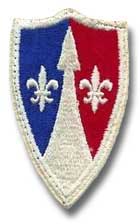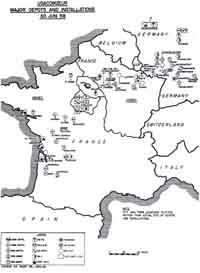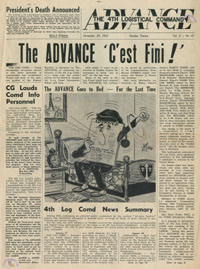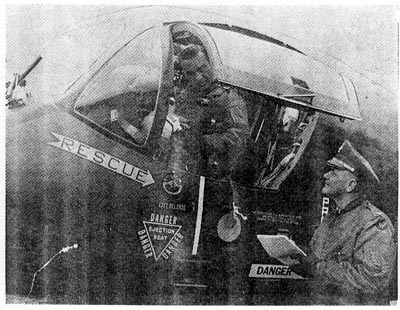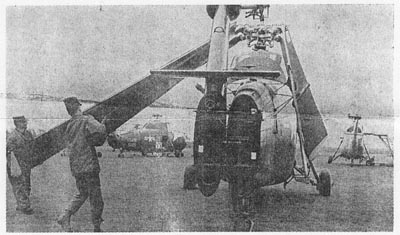| If you do
NOT see the Table of Contents frame to the left of this page, then
Click here to open 'USArmyGermany' frameset |
|||||||||||||||||||||||
|
4th
Logistical Command |
|||||||||||||||||||||||
|
|
|||||||||||||||||||||||
|
|||||||||||||||||||||||
|
|
|||||||||||||||||||||||
| 4th Logistical Command History | |||||||||||||||||||||||
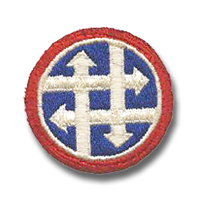 4th Logistical Command Patch, 1960s 4th Logistical Command Patch, 1960s |
|||||||||||||||||||||||
| 1958 - 1963 | |||||||||||||||||||||||
| (Source: 4th
Logistical Command History; unknown date, but probably 1963; located
at the Military History Office, HQ USAREUR) The following are notes that I took in the early 1980s while reviewing the 4th Logistical Command historical manuscript which was located at the Military History Office in Heidelberg. If memory serves me right, the manuscript was very large, over 350 pages. |
|||||||||||||||||||||||
|
The 4th
Logistical Command (4th Log Comd) initially served in
Europe during the build up of US forces in Europe caused by the
outbreak of the Korean War. Headquarters Company, 4th Logistical
Command was activated 10 February 1952 at Leghorn, Italy. The command
was probably responsible for augmenting the line of communications
(including the Port of Embarkation at Leghorn) that served the US
Forces in Austria. 4th Log was again inactivated on 20 January 1954
(probably at
Leghorn). |
|||||||||||||||||||||||
|
|||||||||||||||||||||||
| On 10 July 1957, the following commands were announced or reconfirmed as subordinate commands of ADSEC: | |||||||||||||||||||||||
|
|||||||||||||||||||||||
| The 766th CIC
Detachment was under the operational control of the Director of Security
(G-2), ComZ and assigned to USAREUR; the unit was responsible for
keeping the LOC secure (1958). On 10 December 1957, the following US Army installations were reestablished and assigned to Hqs, USACOMZEUR and further assigned to Hqs, Advance Sec: |
|||||||||||||||||||||||
|
|||||||||||||||||||||||
| On the same date,
HHC, 4th Log Cmd were attached to US Army Garrison, Verdun for logistical
support. This action rounded out ADSEC to allow it to more efficiently
carry on its mission of supporting 7th Army, and at the same time
improved command and control. On 1 January 1959, the following commands were announced or reconfirmed as major subordinate commands of ADSEC: |
|||||||||||||||||||||||
|
|||||||||||||||||||||||
| subordinate commands of ADSEC: | |||||||||||||||||||||||
|
|||||||||||||||||||||||
| subordinate units of ADSEC: | |||||||||||||||||||||||
|
|||||||||||||||||||||||
| Effective 1 March 1959, the following units were assigned to Hq, ADSEC: | |||||||||||||||||||||||
|
|||||||||||||||||||||||
| The 20th Ord
Det (EOD) was assigned to Hq, ADSEC on 17 March 1959. During 1959 the following units comprised the ADSEC Command: |
|||||||||||||||||||||||
|
|||||||||||||||||||||||
|
Now ADSEC's
mission was to develop its depots and installations to the point
where they could provide peacetime logistical support to all US
Army, Navy, and Air Force units in Europe and to store and maintain
certain reserve stocks for emergency or wartime use. |
|||||||||||||||||||||||
|
|||||||||||||||||||||||
| subordinate commands: | |||||||||||||||||||||||
|
|||||||||||||||||||||||
| subordinate units: | |||||||||||||||||||||||
|
|||||||||||||||||||||||
| On
1 July 1961, the Theater Army Support Command was again redesignated
as the 4th Logistical Command. The 1961 "build-up" of US Armed Forces
in Europe had made it necessary to revert to the original ADSEC and
BASEC concept. 4th Log Cmd continued its ADSEC mission, while the
1st Logistical Command 2)
arrived from the US to take control of the Army depots in western
France. The relaxation of tensions permitted the redeployment of 1st Log Comd several months later. The primary mission of the 4th Log Comd throughout this period was to provide logistical support to all US Army Forces in Europe. During September and October 1961 the 4th Logistical Command was influenced by the emergency conditions brought about by the Berlin Crisis when large tonnages of equipment and thousands of men made their way into the theater. These had to be managed and placed within the logistical mission of the ComZ within a comperatively short time. Command and control of the enlarged force was made somewhat easier by the appearance of the 1st Logistical Command. It operated the Base Area of the 4th Log Comd's area of jurisdiction. All of this occurred almost simultaneously with the change beginning to take place from an organization that was technical service oriented to one of functional management, and soon the old depot system gave way to depot complexes embracing more than one technical service. The 4th Log Cmd at its highest point of achievement was required to draw down (troops) to save money and to reduce the LOCs far below what it was before the build-up. This required improved management, competence, and flexibility on the part of the 4th Log Comd -- now burdened with the added responsibility of assuming the mission of the departing 1st Log Comd. The 4th Log Comd operated with a General Staff organization, not with the Directorate Staff required by FM 54-1. In December 1963, 4th Logistical Command comprised the following commands: |
|||||||||||||||||||||||
|
|||||||||||||||||||||||
| At this time,
I believe, all units were removed from assignment to 4th Log and reassigned
to depot complexes or directly to ComZ. Apart from the five BASEC units (+) - Braconne, Chinon, Saumur, Ingrandes, and Croix Chapeau - nearly all the commands had been assigned to ADSEC by December 1957, while several of them, such as (x) Nancy, Metz, Toul, Verdun, and Trois Fontaines, had been with ADSEC since the early 1950s. |
|||||||||||||||||||||||
| 1) MAAGs
- 2) 1st Log Comd - The 1st Logistical Command was relocated from its home station at Fort Bragg, North Carolina, to Europe as part of the mobilization and augmentation of U.S. forces in Europe during the Berlin Crisis of 1961. The command departed on the USNS Gordon from the Army Terminal at Hampton Roads, Virginia, and arrived at Cherbourg, France, on October 19. The unit then moved by train to its new station at Poitiers, France. In France, 1st Log assumed responsibility for operating the Base Logistical Command of the Communications Zone, Europe. War plans called for the creation of an Advanced Log Cmd (ADLOG) and an Base Log Cmd (BALOG). Until the arrival of 1st Log Cmd, 4th Log-West had operated the BALOG area that was to be taken over by the 1st LC. On 30 Sept 1961 Hq, USACOMZEUR had published a plan for the mission of 1st Log Cmd: to organize a BALOG and supervise ComZ depots and port operations in western and southwestern France. Under 1st Log's supervision came 7 depots (Braconne, Chinon, Saumur, and Ingrandes General Depots; Chize and Captieux Ammunition Depots; Croix Chapeau Medical Depot) and the Port Area Command (with Headquarters at La Rochelle, the command comprised a complex of depots and terminals along the French west coast). But the plan was not put into effect right away. On 28 June 1962 1st Log Cmd turned over its mission and area of responsibility to the 4th Log Cmd (except the Port Area Command, and, which was redesignated a major subordinate command of ComZ). The command returned to the United States Aug. 11, 1962, after nearly a year of service in Europe. |
|||||||||||||||||||||||
| 1961 | |||||||||||||||||||||||
(Source: STARS & STRIPES, Sept 6, 1961) |
|||||||||||||||||||||||
The installations of the 4th Logistical Command, consisting of more than 30 activities and depots from all seven technical services, stretches for over 700 miles from near the Spanish border in the south to beyond the Rhine River in West Germany. Commander of the 4th Log Comd is Gen F. J. Chesarck, who was also in command of the Theater Army Support Command (TASCOM), predecessor to the 4th Log Comd. The Command, headquarterd at Verdun, is responsible for all US depots in Europe except those directly under 7th Army (in Germany) and SETAF (in Italy). A measurement of the success of the concept of single comand control over all depots can be seen in the improvements in order-ship time (the time it takes to deliver supplies to the customer once the order is received by a 4th Log depot). Three years ago it took 20-35 days; today it takes only 5-7 days. Of the 40,000 oders a month that come into the depots, less than two percent cannot be filled by stock on hand. The biggest depot is the US Army General Depot at Nancy which covers an area of about eight (square) miles. It comprises nearly 200 buildings and warehouses. |
|||||||||||||||||||||||
| 1964 | |||||||||||||||||||||||
(Source: STARS & STRIPES, Jan 21 1964) |
|||||||||||||||||||||||
The last group (120 officers and EM's) of the 4th Logistical Command departed Maginot Caserne in Verdun and boarded a train to start their journey back to the States, to Fort Lee, VA where the 4th Log has been moved to. |
|||||||||||||||||||||||
| COMMAND NEWSPAPERS | |||||||||||||||||||||||
| The ADVANCE - Some of the issues published while in France | |||||||||||||||||||||||
|
|||||||||||||||||||||||
| Newspaper articles | |||||||||||||||||||||||
|
|
|||||||||||||||||||||||
| The following articles were provided by Daniel Parrish who served with the 256th Signal Company (Combat Support) in France from August 1961 to July 1963 starting at its Detachment in Nancy, to its Headquarters in Verdun (Maginot Caserne), and finally to its Detachment at Brienne le Chateau. | |||||||||||||||||||||||
| (Source: ADVANCE, December 7, 1961, Verdun France APO 122) | |||||||||||||||||||||||
|
Sandhofen
Crews Ready New Aircraft
Top Aviation Crews Deprocess Shipment For Delivery To Units Col William B. Dyer, Commander of the Sandhofen Trans Depot, announced this week the completion of the deprocessing of a large number of Army aircraft received at Bremerhaven Port in October. First Shipment AO-1 fixed-wing aircraft, HU-1B and H-34 helicopters comprised the shipment of replacement and buildup aircraft. The planes marked the first shipment of a large number of AO-1 Mohawks, the new Army observation plane, within USAREUR. Aviation crews from USATDS and aircarft mechanics from COMZ and 7th Army units worked under the direction of Maj Frank E. Alexander of USATDS preparing the aircraft for flight from Bremerhaven to their assigned USAREUR units. The first job of the deprocessing crews was to remove the preservatives wgich had coated the aircraft to protect them from the elements during their voyage across the Atlantic aboard the USNS Card, a Navy "baby" flattop. Planes Protected The Mohawks had been sealed in airtight plastic to protect them from the salty ocean water and white paint had been sprayed over the plastic to deflect the hot rays of the sun. The helicopters were treated with preservative oil and their motor blades folded or removed for the trip. Preservative oil had also been placed in the engines of all of the aircraft. At the port staging area each aircraft was cleaned and thoroughly inspected by the mechanics. Rotor blades were installed on the helicopters and necessary maintenance performed. Finally, the aircraft were checked out in flight by test pilots. "In spite of the harassment of strong winds and heavy rains, the men have done a fine job", stated CWO Roy E. Martens of USATDS, rotor wing deprocessing supervisor and test pilot, upon completion of the project. The last of the aircaft reached their assigned units early this month. |
|||||||||||||||||||||||
|
|||||||||||||||||||||||
|
|
|||||||||||||||||||||||
|
|
|||||||||||||||||||||||
| (Source: ADVANCE, May 17, 1962, Verdun France APO 122) | |||||||||||||||||||||||
| Soldier -
Photographer - Lab Technicians Set Record Breaking Pace in Production 256th Signal Company (Spt) The Photo Laboratory of the 256th Sig Co (Spt) is a going concern, and this is best exemplified by the record-breaking total of 6,808 production units turned out by the section during the month of April. The total far exceeds the previous high of 6,202 set by the Photo Lab in Nov 1961, and it speaks highly of the section which has a quota of 2,600 units per month and is manned by only nine soldier-photographer-lab technicians. The 256th Sig Co (Spt), now under the command of Maj George H. Branigan, Jr., has its headquarters at Maginot Caserne, and has detachments in Metz, Nancy, Toul, TFAD and Vitry, each supported by a photographer. These detachment photographers do not have labs of their own so their picture production is sent here (Verdun) for developing and returned within just 48 hours. Additionally, the Photo Lab also processes the work of all outlying 4th Log Comd units in France and all USAREUR units in the Verdun area. To accomplish this workload means a "doubling-up" in the lab, and this is an outstanding accomplishment of the lab staff, each of whom is equally adept behind the Speed Graphic press camera or in processing an exposed negative. Besides news picture taking and developing, the photo lab also turns out approximately 200 ID card type photos per week, does portrait work for official photos and has a copy camera for charts and reproduction of photos. Heading up the photo lab is Lt Robert L. Pessini, Pictorial Officer, while Sgt James W. Sword is NCOIC and Sp-5 Joseph W. Harris is the senior photographer. Other members of the staff are Sp-4s Robert W. Lennox, Robert H. Morrow, Lowell K. Warren, James A. Bis, Ronald L. Hoffman, James E. Beauchamp, and Pfc Michael A. Marsh. A separate, but highly important branch of the Photo Lab is the unit's Film and Equipment Exchange which services more than 150 units throughout France and Germany with training films, and equipment. The branch also trains about 40 projectionists per month from 4th Log units. Presently operated by three men - Sgt Melvin D. Baker, NCOIC, Sp-4 Clyde E. Green and Pfc Walter L. Richards - the Film Exchange runs its projectionist school three days a week, training students in the operation and minor repair of five types of Army camera equipment. Included in the school's instruction program are field expeditions, trouble-shooting, operation and means of keeping audiences alert and entertained. For the over 300,000 soldiers and civilians who see films during a year's time, the Verdun Film Exchange keeps a constant stock of 1,350 training films on hand and can obtain 11,000 more through the USAREUR Central Film and Equipment Exchange in Karlsruhe, Germany. Another primary mission of the exchange is maintenance and repair, and Sgt Baker and his staff are well-versed in the care of the 117 pieces of equipment used. The mission of the 256th Sig Co (Spt) Photo Lab and Film and Equipment Exchange is photography, lab technician work, portrait and copy work, issuing of training films, running a projectionist's school and the repair and maintenance of camera equipment. It is a big job... but handled smoothly and efficiently by a top staff of US Army soldier-photographer-technicians. |
|||||||||||||||||||||||
| Webmaster Note: the 256th Sig Co (Spt) was part of the 1st Signal Group in France and was responsible for supporting the 4th Logistical Command. | |||||||||||||||||||||||
